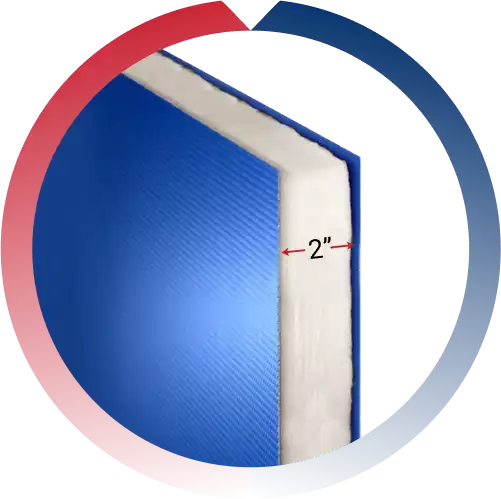What are R8 & R9 Thermal Curtain Walls?
Divides Temperature Zones in the Following Applications:
- Transportation Facilities
- Warehouses with Temperature Sections
- Creates a Higher Temperature Area for Humans or Animals
- Or Similar Applications


Divides Temperature Zones in the Following Applications:



Medium Flexible Insulated Curtain Wall
Medium weight temperature zoning products of up to R8 can be made in a retractable type of design, which builds in temperature zoning flexibility. Softwall construction is utilized up to R15, at which point the construction would shift to a semi-rigid, stationary climate control curtain. A major and significant factor in the effectiveness of your curtains is also edge sealing, which would eliminate the airflow from where all sides of the climate curtain meet the building’s interior construction.
Zoning each area to fit temperature differential requirements is the primary function of AmCraft climate curtain systems. Our thermal warehouse curtains double as a room separator and climate control, which will provide you with amazing savings on heating and cooling costs as well as creating the desired environment for each given space in your facility.
Divides Temperature Zones in the Following Applications:
Medium Flexible Insulated Curtain Wall
Medium weight temperature zoning products of up to R-8 can be made in a retractable type of design, which builds in temperature zoning flexibility. Softwall construction is utilized up to R-15, at which point the construction would shift to a semi-rigid, stationary climate control curtain. A major and significant factor in the effectiveness of your curtains is also edge sealing, which would eliminate the airflow from where all sides of the climate curtain meet the building’s interior construction.
Zoning each area to fit temperature differential requirements is the primary function of AmCraft climate curtain systems. Our thermal warehouse curtains double as a room separator and climate control, which will provide you with amazing savings on heating and cooling costs as well as creating the desired environment for each given space in your facility.


R8 Retractable Construction
R9 Stationary Construction
Contact Amcraft’s
Since a given air space to material structure ratio is specific to each type of insulation, it is common knowledge that compressing any insulation so as to fit more of it into a given space will increase the overall R-value of that space, but not proportionally to the additional insulation. For example, two layers of 3” thick R10 insulation compressed into a 5” space will NOT render an R20 insulation value.
The three modes in which heat loss occur are as follows:
It is best to know all aspects of the potential temperature barrier situation as different insulations combat heat transfer better than others in a given arrangement (i.e. interior/exterior, sun, wind, etc). To achieve a better understanding of what your project needs are, contact us today! Our technical representatives can assist you with the requirements of your area.
Headquarters